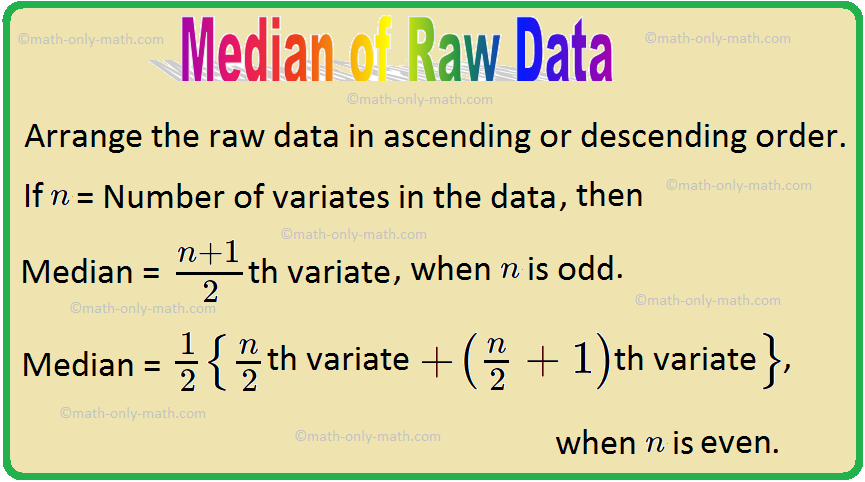Subscribe to our ▶️ YouTube channel 🔴 for the latest videos, updates, and tips.
Median of Raw Data
The median of raw data is the number which divides the observations when arranged in an order (ascending or descending) in two equal parts.
Method of finding median
Take the following steps to find the median of raw data.
Step I: Arrange the raw data in ascending or descending order.
Step II: Observe the number of variates in the data. Let the number of variates in the data be n. Then find the median as following.
(i) If n is odd then \(\frac{n + 1}{2}\)th variate is the median.
(ii) If n is even then the mean of \(\frac{n}{2}\)th and (\(\frac{n}{2}\) + 1)th variates is the median, i.e.,
median = \(\frac{1}{2}\left \{\frac{n}{2}\textrm{th Variate} + \left (\frac{n}{2} + 1\right)\textrm{th Variate}\right \}\).
Solved Examples on Median of Raw Data or Median of Ungrouped Data:
1. Find the median of the ungrouped data.
15, 18, 10, 6, 14
Solution:
Arranging variates in ascending order, we get
6, 10, 14, 15, 18.
The number of variates = 5, which is odd.
Therefore, median = \(\frac{5 + 1}{2}\)th variate
= 3rd variate
= 14.
2. Find the median of the raw data.
8, 7, 15, 12, 10, 8, 9
Solution:
Arranging the variates in ascending order, we get
7, 8, 8, 9, 10, 12, 15.
The number of variates = 7, which is odd.
Therefore, median = the \(\frac{7 + 1}{2}\)th variate
= 4th variate
= 9.
3. Find the median of the ungrouped data.
10, 17, 16, 21, 13, 18, 12, 10.
Solution:
Arranging the variates in ascending order, we get
10, 17, 16, 21, 13, 18, 12, 10.
The number of variates = 8, which is even.
Therefore, median = mean of the \(\frac{8}{2}\)th and (\(\frac{8}{2}\) + 1)th variate
= mean of the 4th and 5th variates
= mean of 13 and 16
= (\(\frac{13 + 16}{2}\)
= (\(\frac{29}{2}\)
= 14.5.
4. Find the median of the raw data.
8, 7, 5, 6, 3, 8, 5, 3
Solution:
Arranging variates in descending order, we get
8, 8, 7, 6, 5, 5, 3, 3.
The number of variates = 8, which is even.
Therefore, median = mean of \(\frac{8}{2}\)th and (\(\frac{8}{2}\) + 1)th variate
= mean of 4th and 5th variate
= mean of 6 and 5
= \(\frac{6 + 5}{2}\)
= 5.5
Note: The median need not be form among the variates.
From Median of Raw Data to HOME PAGE
Didn't find what you were looking for? Or want to know more information about Math Only Math. Use this Google Search to find what you need.



New! Comments
Have your say about what you just read! Leave me a comment in the box below. Ask a Question or Answer a Question.